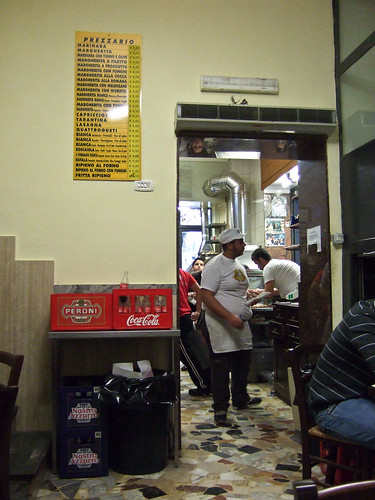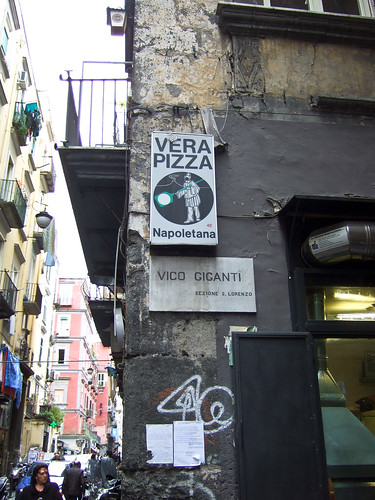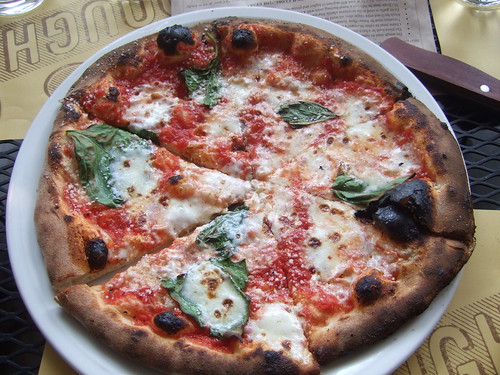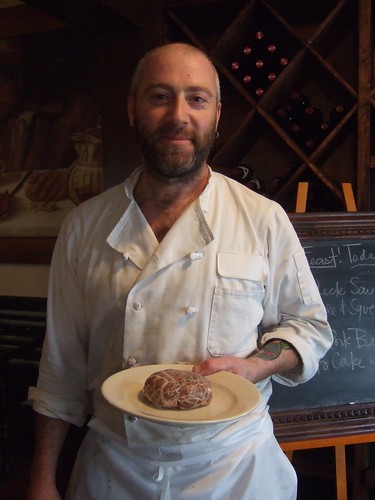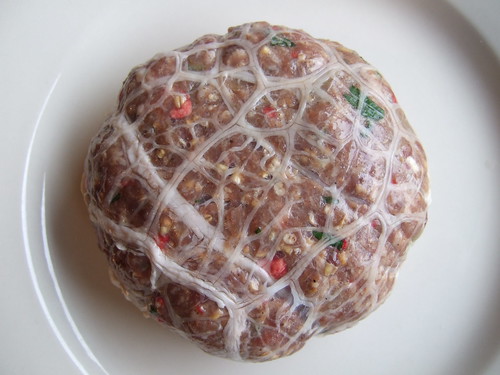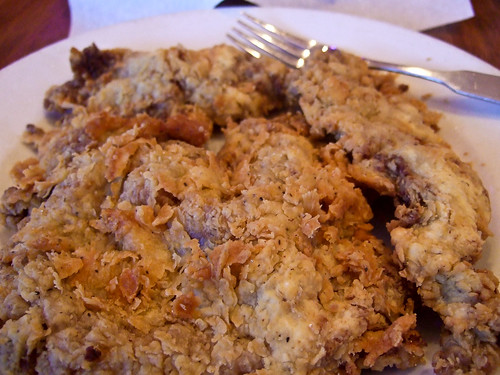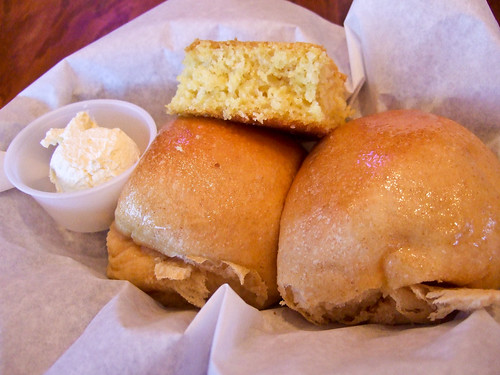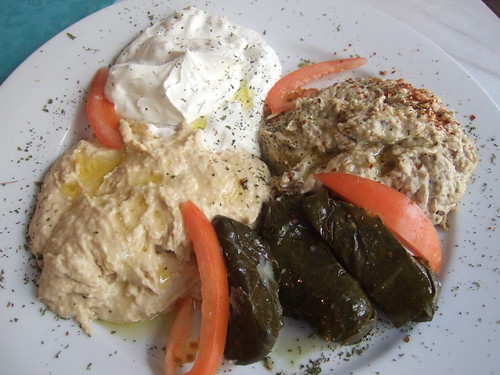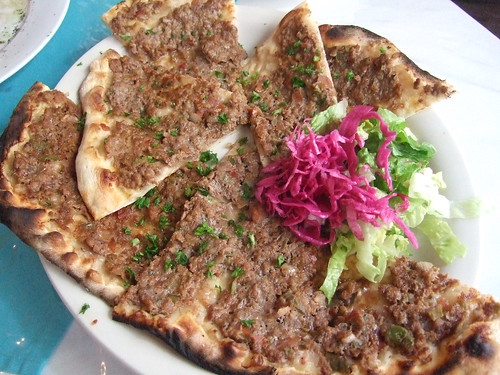Tuesday, April 12, 2011
Houston Foodie is now J.C. Reid, Texas
Monday, March 21, 2011
The Truth About Neapolitan-style Pizza
My waiter, a young man in his twenties wearing a dirty apron that sheathed a prodigious belly usually seen on men some twenty years older, was the model of indifference.
He spoke no English, and as I pointed to the menu to place my order for a pizza, he never looked up from his order pad. The dining room was dim and dusty — this restaurant had been around since 1936 — with mountainous piles of fetid, decomposing garbage just outside the front door. A few feet away on the adjoining street, cars and motorbikes competed in a diabolical contest to see who could lean on their horns the longest and loudest. When the pizza arrived, it was small (by American standards), misshapen, unsliced, charred all around and sparse on the toppings. This was the best pizza I'd ever had, in the best pizza joint I'd ever been to.
Read More...I was in Naples, Italy. The pizza joint was Antica Pizzeria e Friggitoria di Matteo, or just Di Matteo for short. It's located on Via dei Tribunali, a narrow, claustrophobic main thoroughfare that boasts several of the oldest pizzerias in the world. I was here to find out why Neapolitan pizza, or Pizza Napoletana, is considered by many to be the best and most authentic style of pizza.
There are many different "styles" of pizza. If you grew up in the U.S., you're probably most familiar with the "New York-style" pizza; basically a large, round "pizza pie" with a spongy crust that's topped with any number of ingredients and cooked in a commercial gas oven. In New York City you often buy this pizza "by the slice" from guys with names like Sal or Carmine. Another style from New York is the "coal-fired" pizzas made famous in joints like Lombardi's and Grimaldi's. More recently, authentic "Neapolitan-style" pizza — what has historically been known has Pizza Napoletana — has gained popularity in the U.S.
What's so special about Pizza Napoletana? Like many Italian foods, it boils down to history and taste. With regard to taste, Pizza Napoletana is the essence of simplicity; a few high quality ingredients combined and cooked in such a way to create a whole greater than the parts. The iconic version of Pizza Napoletana is the Margherita. A charred crust, thin in the middle and thicker around the edges, fragrant of yeast and bread, combines with the acidity of the tomato sauce and the richness of the Mozzarella di Bufala cheese, and then sprinkled with sea salt and fresh basil leaves. The pizza is baked in a wood-fired oven at 900 degrees for 60-90 seconds.
The history of pizza is long, but suffice it to say that mankind has been slathering ingredients on top of baked dough for thousands of years. Of course, pizza is most often associated with Italy, particularly the city of Naples. Pizza Napoletana dates back to the early 1700s (corresponding to the introduction of tomatoes in Italy), and the recipe of the iconic Margherita pizza to the early 1800s. The name was established in 1889 when the Queen of Italy, Margherita of Savoy, visited Naples and was presented with a pizza made with ingredients featuring the colors of the Italian flag: red tomatoes, white cheese and green basil. There is still a pizzeria in Naples today — Pizzeria Brandi — that traces its origins to the pizzaiolo (pizza maker) Raffaele Esposito who is credited with preparing the pizza for the Queen.
So for pizza connoisseurs, true Pizza Napoletana is the gold standard of pizza styles, both in taste and history. But for those of us who aren't pizza experts, how do we tell when Pizza Napoletana is "real" and not "imitation?" Can we get real Pizza Napoletana in the United States.? In Texas? Who decides what's real and what's fake? Is real always better than fake?
The short answer is: yes, true Pizza Napoletana is (obviously) better than versions that use lower quality ingredients or shortcuts in the preparation. And there is a system in place to ensure that we as consumers get the real deal. And you can get it in Texas. The story of "true" Pizza Napoletana begins in Naples in 1984 with the formation of the Associazione Verace Pizza Napoletana ("Association for True Neapolitan Pizza").
The AVPN is a trade association tasked to promote and defend the true Pizza Napoletana. Among other activities, it sets guidelines for the ingredients and preparation of true Pizza Napoletana, and certifies that restaurants and pizzaioli are properly trained in those guidelines. A pizzeria that successfully acquires certification can display a "Vera Pizza Napoletana" plaque as a way to let consumers know that it makes the real Pizza Napoletana. Furthermore, in February 2010, The European Union granted Pizza Napoletana legal status as a Specialità Tradizionale Garantita (Traditional Specialty Guaranteed). This is a type of trademark that prevents "fake" or imitation makers of Neapolitan-style pizza (which may be of inferior quality) from claiming they produce true Pizza Napoletana.
Here in the U.S., the AVPN has established an organization known as VPN Americas as the official delegation for true Pizza Napoletana. Based in California, it follows the exact same guidelines as the Naples association, and is responsible for certifying pizzerias and pizzaioli in the U.S. Currently there are over 40 pizzerias certified as Vera Pizza Napoletana in the United States.
In Texas, there are three VPN certified pizzerias: Cavalli Pizzeria in Irving, and Dough Pizzeria and Luciano Pizzeria in San Antonio. Dough is perhaps the most well-known Vera Pizza Napoletana (VPN) restaurant in Texas, with a loyal clientele and new plans to expand to Dallas. In my experience, Dough's "Margherita STG" pizza is the closest you will get to the real thing in Texas. In Houston, Chef Michael Kramer of The Tasting Room Wine Cafe has completed VPN training in California. The Tasting Room CityCentre location has a new wood-fired oven, and although the restaurant itself is not yet VPN certified, it is producing pizza Margherita in the tradition of true Pizza Napoletana.
It's a unique combination of globalization and legally-protected local food traditions that allows the spirit and flavor of true Pizza Napoletana to be made available worldwide. Obviously there are many pizzerias and styles of pizza throughout the world that are of a high quality and don't necessarily need a certification. But for those of us who are interested in the traditions and history of what we eat and cook, Vera Pizza Napoletana is a great resource to make sure we get the real deal when it comes to Neapolitan-style pizza.
This blog entry was originally posted 14 March 2011 on the www.29-95.com website.
Tuesday, March 1, 2011
Who's afraid of a little haggis?
This is a story about haggis, a dish traditionally associated with the cuisine of Scotland. There are many myths, legends, rumors, and even poems associated with haggis. But most importantly, haggis is a delicious and nutritious dish.
I want to get that out in the beginning (the delicious and nutritious part) because the story of haggis can be a bit of a bumpy road for those outside of Scotland, particularly in those cultures that shy away from eating the internal organs of animals (I'm looking at you America).
There's an old saying, "You don't want to know how sausage is made." In other words, we all love to eat sausage, but if we knew what ingredients went in to it, we might not want to eat it anymore. The same is true for haggis. But the story of haggis is irrevocably tied to its recipe and ingredients, so there's no way around a full airing of its preparation. So here goes.
Read More...The main ingredient in haggis is sheep's "pluck." This is an inclusive term for the internal organs of a sheep, specifically the trachea (windpipe or throat), lungs, heart and liver. These materials are chopped up and combined with other ingredients like oats, onions, suet (sheep's fat), and various spices like thyme, sage and rosemary. The whole lot of it is mixed up and stuffed into a sheep's stomach or ox bung (don't ask) and then boiled in water.
The dish is plated with a side of neeps and tatties, the cheeky Scottish term for mashed potatoes and rutabaga. The combination isn't random; the potato and rutabaga offer a welcome starchy/sweet balance with the intense earthiness of the organ meat. The haggis is either left in its casing, in which case you ceremonially cut it open to reveal the haggis inside, or it's removed and spooned on to the plate for easy access. Traditionally, the drink of choice when eating haggis is, not surprisingly, Scotch whisky.
I asked my friend and expatriate Doug Robertson about his experience with haggis growing up in Scotland. "It's more of a special occasion dish. We didn't really cook it at home. It's popular in rustic restaurants, especially for breakfast. It's obviously a big deal for a Burns supper."
Burns supper? That would be Robert Burns, eighteenth century poet and Scotland's "favorite son." His poems and folk songs are well known, including Auld Lang Syne and Tam O'Shanter. Every year on or around January 25th, Scottish societies, clubs and admirers all over the world hold "Burns suppers" to celebrate his birthday. Did I mention that Robert Burns wrote a poem to haggis? Indeed, he wrote an entire poem, Address to a Haggis, literally singing the praises of the Scottish national dish.
The ceremonial "entrance of the haggis" is a big part of a Burns supper, with a large haggis carried in as bagpipes play. Address to a Haggis is read, a toast is made with whisky, and the haggis is divvied up among the guests. During the recent Burns celebrations this past January, Houston's Feast Restaurant was asked to prepare haggis for several suppers here.
Feast is known for serving English cuisine, so I asked co-owner, chef and Englishman Richard Knight about Scottish haggis. "You don't see it a lot in England, but with the recent popularity of nose-to-tail cooking, you'll occasionally see haggis on menus in London." According to Knight, his English business partner and chef James Silk spent time cooking in Edinburgh (Scotland), and that's the basis for their recipe.
In addition to making haggis for Burns suppers, Feast put the dish on its regular menu over a weekend in January. It's rarely on the menu at Feast, and I've never seen it on any other restaurant menu in Houston. I'd never tasted haggis so I made a reservation for dinner, bringing along my friend Peggy, an American who had lived in Scotland and eaten the haggis there. Referring to the Feast version, she commented, "It's meatier than the haggis I remember. I recall a lot more filler in Scotland, a lot more oats." That said, we both agreed that the haggis at Feast was delicious.
The comment regarding "filler" in haggis is pertinent. Like a lot of infamous or exotic dishes, the recipe for haggis is historically made up of stuff left over after the "good stuff" is finished. So after the exquisite lamb chops and rack of lamb and other conventional cuts of the lamb were used (usually eaten by the wealthy), what was left over - the organs, etc. - were chopped up, mixed with "filler" (like oats) to make it more substantial and sometimes nutritious, and then served (usually to poor people) as a dish like haggis.
Today, haggis isn't just a poor man's dish, and it's not just served in restaurants and at Burns suppers. Haggis is available in a can. And frozen. And it's shipped to haggis lovers (read: Scottish expatriates) all over the world. Except in the United States. In 1971, for health reasons, the U.S. prohibited the import of food containing sheep lung. Then in 1989, the U.S. banned the import of all beef and lamb from the United Kingdom due to the "mad cow disease" crisis. So what's a haggis-loving Scottish expatriate in the U.S. to do?
I called Debbie Tosh, buyer and general manager (and expat Scot) at British Isles, a store in Houston that specializes in products and food from the U.K. "We have canned haggis. It's made from Scottish recipes, but manufactured in the U.S." I asked the obvious question, how much of it does she actually sell? "We sell a lot. There's a big community of Scottish expatriates in Houston, mostly associated with the oil industry. We sell by the case for Burns suppers. And we do sell some as gag gifts."
I bought a couple of different kinds of canned haggis at British Isles to try them out. One of them is made by Caledonian Kitchen which, ironically, is manufactured in Ohio by a company headquartered near Dallas by owners who have no connection to Scotland other than their distant ancestry. In 1992, on a pilgrimage to Scotland to trace his ancestry, owner Jim Walters got hooked on haggis. Back in the U.S. he realized there was no haggis to be found, so he made his own based on Scottish recipes. He started serving it at Scottish festivals in the U.S. and eventually started canning it and selling it.
In 2003, a Scottish magazine invited Walters to submit his haggis to a tasting competition in Scotland. Canned haggis from nine manufacturers in Scotland plus Walter's Texas haggis were entered. The Texas haggis came in an impressive 5th place. I asked Walters if he was there to accept either bouquets or brickbats from the Scots for his impressive placing. "No, they wouldn't let me attend. I think they thought I'd show up in a kilt and cowboy boots!"
So what does canned haggis taste like? First, it's more pungent than the Feast restaurant version. The earthy, meaty, somewhat metallic flavor of the offal (organs) is more pronounced, though not necessarily distasteful for most people. If you've ever eaten beef or chicken livers, the overall flavor of haggis is somewhat similar. The pungent flavor is cut by the nutty oats, which are more prominent in the canned version. The oats also offer a nice crunchy texture. The spices are also noticeable, and add an extra dimension of flavor.
My conclusion? Haggis is perhaps an acquired taste, but it's certainly nothing to be afraid of.
This blog entry was originally posted 15 February 2011 on the www.29-95.com website.
Monday, February 21, 2011
CFS Challenge: Black-eyed Pea vs. Saltgrass Steak House
We continue our search for the best chicken fried steak in Houston by visiting two chain restaurants known for tasty CFS.
The Black-eyed Pea restaurant chain has been around for decades, and in its earlier incarnation as a series of Texas-based, privately owned restaurants, earned a reputation for one of the best chicken fries steaks in the state. I hadn't visited a Black-eyed Pea restaurant in years, and hadn't had a CFS there in more than a decade. Did it still make a great CFS?
Similarly, Saltgrass Steak House started as a private restaurant chain in Houston and was eventually acquired by the Landry's Restaurant group in 2002. The CFS here is not often mentioned in Houstonians' or Texans' lists of great CFS, but it does seem popular with out-of-towners. I'd never eaten at a Saltgrass Steak House and it seemed like a worthy local competitor to the long-storied reputation of the Black-eyed Pea CFS.
Read More...Black-eyed Pea
On a recent weekday lunch the dining room at the only remaining Black-eyed Pea inside the loop (4211 Bellaire Blvd.) was full. The clientele was older. This isn't surprising, since the restaurant chain has been around for almost thirty years and the menu features the same "home-style" American comfort foods it has always served. Roast turkey breast, made-from-scratch meat loaf, pot roast, and of course chicken fried steak keep the regulars coming back year after year.
This is a table service restaurant. The dining room is comfortable and well-lit, if a bit the worse for wear, and my servers on this day were friendly and attentive. I noted that the market segment served by the Black-eyed Pea is quite successful — a step up from comfort food cafeterias like Luby's, but not as fancy or expensive as a slightly more upscale chain like Saltgrass. This is comfort food in a comfortable atmosphere at a comfortable price.
The CFS here comes in two sizes: the regular chicken fried steak ($8.99) and the "Texas sized" chicken fried steak ($10.99). Two vegetables, rolls and cornbread are included. I ordered the Texas size, with side orders of mashed potatoes and steamed broccoli, and the requisite ginormous glass of unsweetened iced tea.
The breakdown
Meat: The Texas sized version filled a whole plate, with the meat aggressively tenderized -- in some places almost falling apart -- with a good thickness and properly seasoned. It was fork tender and contained only a couple of gristly pieces.
Crust: Fried golden brown, with areas that were thinner/thicker and lighter/darker with spots of the underlying meat occasionally peeking through. Nicely seasoned and flavorful. The crust adhered to the meat perfectly.
Gravy: It was average. Thickness and texture were good, with a respectable richness of flavor. Seasoning was light and meant to be inoffensive, I'm sure. Adding a bit of salt and a lot of pepper would greatly improve this gravy.
Value: Very good. For $10.99, the CFS was huge and well-executed and the sides were respectable. The bottomless basket of rolls and cornbread is a nice (and filling) tradition.
Extras: Excellent. The rolls and cornbread may not be like your momma made them, but they are addicting. The rolls are unusually, but not unpleasantly, sweet with a gooey, doughy texture. They come out steaming hot and drenched in butter. The cornbread is similarly sweet and addictive — certainly a crowd-pleaser but probably unacceptable to the purists who believe cornbread should feature a more bitter flavor.
Overall grade: B+ The Pea still makes a mean chicken fried steak. This will come as a relief to those of us who grew up on the CFS here, but don't get back often.
Saltgrass Steak House
Salt Grass Steak Houses dot the suburban landscape of Houston. I can never remember exactly where one is, other than it's usually somewhere along a major highway like I-10 or I-45. The closest one to my house is on I-10 near Shepherd, and that's where I visited on a recent weekday lunch. This location has a small dining room with clubby, comfortable booths lining the walls. The crowd consisted mainly of urban professionals and office workers.
For lunch, you've got two choices for the CFS: the "lunch cut" ($9.99) and the full dinner size ($13.99). The dinner portion includes a soup or salad, beer bread, and one side dish. I went with the full dinner portion, a salad, and a side of macaroni and cheese.
The breakdown
Meat: Nicely tenderized; perhaps too much, as the meat was a bit thin. Good flavor and freshness.
Crust: Flavorful, crispy and well-seasoned, but there was large amount of crust relative to the meat. There was virtually no adhesion of the crust to the meat, a deal-breaker for some.
Gravy: Outstanding, some of the best I've had in Houston. Wonderfully creamy texture, great depth and richness of flavor. Good seasoning. I'd even like a bit more pepper in there.
Value: Good. $13.99 for a large CFS, side and salad is very reasonable.
Extras: Poor. The "beer bread" that accompanied our lunch on this day was dry, crumbly and flavorless. The salad was a standard-issue iceberg lettuce concoction.
Overall grade: B. The CFS at Saltgrass is overall pretty good, but somewhat thin relative to other chicken fried steaks in Houston, and the lack of the traditional rolls and cornbread is a drawback in my opinion.
The Black-eyed Pea takes this round. The overall quality and value is excellent. But like any CFS comparison between two restaurants, wishful exchanges of different components is always in order. The Black-eyed Pea rolls and cornbread would greatly improve the experience at Saltgrass. The Saltgrass gravy would push the Black-eyed Pea experience into the A or A- category. Such is the creative thinking of the CFS connoisseur.
~ ~ ~ ~ ~
Previous CFS challenge:
CFS Challenge: Hickory Hollow vs. Ouisie's Table
This blog entry was originally posted 7 February 2011 on the www.29-95.com website.
Tuesday, February 8, 2011
Turkish Cuisine Delights
The staff at Istanbul Grill in Houston's Rice Village wear T-shirts emblazoned with a symbol of concentric blue and white circles. Round glass objects of the same design hang from the walls of the restaurant.
For anyone who has ever visited Turkey, you will recognize these objects as the same ones sold in stalls of Istanbul's Grand Bazaar, hung from the walls in commercial establishments, and dangled from the rear-view mirrors of taxicabs. This is the nazar boncugu, or the evil eye stone that's meant to ward off bad spirits. It's the first and most prominent sign that you are in one of Houston's relatively few Turkish restaurants.
Just looking at the menu here, you might not be so sure you're in a Turkish restaurant. Kebabs, hummus, tabouli and baklava are prominently featured — all dishes with a Mediterranean, Middle Eastern or South Asian association, at least to the eyes (and palate) of the Western diner. Undoubtedly, native Turks would vehemently disagree that the kebabs produced in Istanbul are even remotely similar to those made in Tehran, much less London or Berlin. If politics and religion are historically the major sources of international conflict, a nation's claim to its cuisine, dishes and ingredients can't be far behind.
Read More...In Houston, Turkish cuisine is less well-known than its culinary cousins from Greece, India, Pakistan or Lebanon. Three (out of maybe four or five) of Houston's Turkish restaurants are located a couple of miles from each other inside the loop — Istanbul Grill and Pasha in Rice Village, and Turquoise Grill just north on Kirby near the Southwest Freeway. Although menu items may seem similar, it's been my experience that Turkish cuisine in Houston has stayed closer to its roots than Greek or Indo/Pak cuisine, which over the years has ballooned in portion sizes and unsubtle uses of mass-produced ingredients and palate-destroying spices. Much of the Turkish cuisine you get in Houston is simple, fresh and flavorful, and accommodating to both meat lovers and vegetarians alike.
A meal will often begin with a glass of hot tea, or cay (pronounced chai). Drinking tea in Turkey is an important social tradition — outdoor cafes are filled with Turks drinking tea, smoking and socializing, all tended to by waiters darting between tables, carrying impossibly tall stacks of glasses in each hand. On the occasion I've stepped in to a Turkish restaurant in Houston for an order to-go, the owner will often bring out a glass of hot tea while I wait — a perfect example of the hospitality for which Turkish people are known.
The appetizer course of a Turkish meal, the meze, is usually made up of soups, salads, dips and spreads, and small portions of meat or fish. Most Turkish restaurants offer a meze tabagi, or mixed appetizer plate, which allows you to choose 4-8 dishes to sample. It's a great way to try the many different options. On a recent visit to Turquoise Grill, we ordered a meze tabagi which included patlican salatasi (baba ghanoush, or cooked and mashed eggplant), hummus (chickpea dip), yaprak sarma (dolma, or stuffed grape leaves), and haydari (lebni, or strained yogurt). This course is served with pide bread, similar to the Greek pita bread, but thicker and fluffier, and often sprinkled with sesame seeds.
Main courses feature a wealth of fried and grilled meat and seafood dishes, as well as dishes featuring wonderfully grilled and seasoned vegetables that are a godsend for long-suffering vegetarians. The usual beef, chicken and lamb kebabs are here; for a distinctive Turkish version try the Iskender kebab, named after its Turkish inventor, Iskender Efendi. Long, thin slices of doner kebab (lamb) are layered over butter-soaked pieces of pide bread, then topped with a tomato sauce and served with a side of yogurt. Another unique Turkish dish is lahmacun (pronounced lah mah zhoon)— crispy, thin pide bread topped with a paste of minced lamb and beef, onion, tomato, garlic and parsley. A side salad of crispy, vinegary red cabbage and lettuce is spread on top, a squeeze of lemon is added, and the lahmacun is rolled or folded together and eaten by hand.
Another type of "Turkish pizza" is known as pide, named after the pide bread that forms the crust of the boat-shaped pizza. Thicker and more substantial than lahmacun, pideler features many types of toppings such as sausage, cheese, beef and lamb. A delicious vegetarian pide features onions, bell peppers, tomatoes, mushrooms and cheese. And in an endearingly diplomatic gesture, many Turkish restaurants will list a "calzone" on the menu, really just a folded-over pide, for timid eaters or kids looking for something familiar.
There are the usual sweets for dessert — honey and pistachio-laced baklava, and a more subtle sutlac, or oven baked rice pudding. But the true culmination of any Turkish meal is coffee. Turkish coffee is not distinguished by the ingredients (though it is often infused with sugar or cardamom), but rather by the preparation method. Coffee beans are ground into the finest possible powder, then mixed with hot water until the flavors are extracted and the powder settles on the bottom of the cup. The result is visually murky, with a grainy-thick texture, and with an intensely focused flavor of coffee-caramel-earthiness.
Much like the diverse nation of Turkey, which sits at a geo-political crossroads between Europe and Asia, the cuisine of Turkey is a rich fusion of dishes and ingredients derived from neighboring regions, as well as dishes unique to the country itself. The Turkish restaurants of Houston offer an authentic snapshot of this world-class cuisine and culture that is a fresh, unique and reasonably priced alternative to the city's usual Mediterranean food offerings.
This blog entry was originally posted 24 January 2011 on the www.29-95.com website.
Friday, January 28, 2011
Spaghetti all'amatriciana: Layers of flavor and history
The Via Salaria — the Salt Road — was one of the earliest roads built by ancient Rome to lash together its far-flung empire.
The actual path of the road predated the Romans — the Sabine people of central Italy would trek down from their mountain redoubts to the mouth of the Tiber river, where they would collect sea salt which at the time was a prized commodity. Today the Via Salaria is labeled the SS4, or Strada Statale 4 (State Highway 4). It's an otherwise mundane two-lane blacktop that overlays the track of the original Roman road, exceptional only in the path of history which it follows both literally and figuratively.
Read More...We were driving north on the SS4 from Rome to the small town of Amatrice. It's generally agreed that Amatrice is the birthplace of the classic pasta dish spaghetti all'amatriciana. I'd eaten amatriciana for years when visiting Rome, but like many dishes and cuisines in this part of Italy, the provenance, recipe and ingredients of amatriciana were all in dispute. I decided to visit the supposed birthplace of the dish and find out what an authentic version of amatriciana really tastes like.
First, a few notes about the many-layered history of the dish. The basis for the recipe begins in the 15th or 16th century when migrant shepherds living in a nearby town used readily available ingredients to make the classic dish pasta alla gricia. The ingredients were pecorino (a readily available sheep's milk cheese), guanciale (salt-cured pork cheek), black pepper and dried pasta (the final three ingredients being resistant to spoilage). Pasta alla gricia became known as amatriciana bianca or the "white amatriciana," referring to the color of the sauce made from the pecorino cheese.
Then, sometime in the 17th century, the tomato was introduced to Italy from the New World. It was only then that the Italian love affair with tomatoes began. Tomato sauces became a staple of Italian cooking, and eventually came to define Italian cuisine as it traveled with waves of Italian immigrants all over the world. The classic amatriciana bianca recipe was no match of this pomodoran invasion, and a generous portion of tomato sauce was layered on top of the original shepherd's concoction. Somewhere along the way, red pepper flakes were added to the recipe to give it some spicy heat. Amatriciana bianca had transformed into amatriciana rosso and a canonical recipe was established.
As we drove into town, a sign announced our arrival into Amatrice. While signs in the U.S. may celebrate a city as home to the largest ball of twine or the local high school football team, city signs in Italy often denote the birthplace of an emperor, or perhaps more importantly, the birthplace of a dish like spaghetti all'amatriciana. Such was the case in Amatrice.
Our destination was Albergo-Ristorante La Conca, a source for traditional amatriciana mentioned in the book Italy for the Gourmet Traveler. The restaurant was empty for lunch on a bright day in November (off season for this area of Italy). But the staff was eager to take care of us; they knew exactly what we wanted when we walked in the door (did we have an American flag painted on our foreheads?). The spaghetti all'amatriciana here hewed to the traditional recipe: pecorino, guanciale, tomato sauce, black pepper, red pepper flakes and dried spaghetti pasta. It was the best I've ever had.
But the story doesn't end there. The amatriciana I ate in Amatrice only vaguely resembled the dish I'd eaten in Rome for so many years. What accounted for the discrepancy? The ancient Romans, of course, were known for assimilating the culture and traditions of its conquered peoples. Similarly, and perhaps even more controversially, contemporary Romans have assimilated amatriciana as a classic dish of cucina romana — the cuisine of Rome.
This next layer in the flavor and history of amatriciana originated when migrations from the countryside (Amatrice) to the city (Rome) brought an influx of regional cooking into the capital city. There, the dish got its own slightly different version of the name: pasta alla matriciana. Ingredients were added in various combinations: onions, garlic, white wine, basil, sage. The pasta is usually bucatini, a thicker, hollow version of spaghetti. Indeed the dish I'd been eating in Rome all those years was bucatini alla matriciana. A delicious dish no doubt, but lacking in the focused simplicity of the classic spaghetti all'amatriciana I sampled in Amatrice.
Back in Houston, I searched for a restaurant that serves amatriciana. Could I find a faithful representation of this dish in a city known for many middling Italian restaurants, and only a few good ones? Scouring restaurant website menus yielded one solid result: the "penne amatriciana" at Nino's on West Dallas. A weekday lunch visit revealed a generous portion of the dish that was both delicious and well-made, if not wholly faithful to the original recipe. The amatriciana at Nino's included onions, making it a closer relative of the Roman version. In a nod to the Americanization of the recipe, pancetta is substituted for guanciale (which can be hard to find in the U.S.), and Parmigiano-Reggiano cheese was offered instead of pecorino.
Still, even if a restaurant in Houston offered a faithful recipe of the dish, it would be difficult to exactly reproduce the version from Amatrice due to the obvious lack of access to the local Italian ingredients: the velvety richness of the rendered guanciale, the salty sharpness of the local pecorino cheese, the tangy sweetness of the Casalino tomatoes that are a hallmark ingredient of the dish in Italy. Certainly, using the original recipe and good quality ingredients, a delicious approximation of the dish is possible outside of Italy. But I've resigned myself to the fact that a taste of the real amatriciana is only attainable by a flight to Rome and a drive north on the Via Salaria to Amatrice — the "citta degli spaghetti all'amatriciana."
This blog entry was originally posted 12 January 2011 on the www.29-95.com website.
Monday, January 17, 2011
Restaurant rules to survive (and thrive) by
I recently wrote about etiquette tips that diners can use to make the restaurant dining experience more enjoyable. Similarly, there are rules that restaurants can follow to make the diner's experience more enjoyable and thus have the salutary effect of creating a successful and thriving restaurant.
These rules may seem obvious. But a sampling of several new restaurants opening in Houston reveals surprising oversights in even the most basic tenets of running a restaurant. Reasons are numerous and well-documented -- a wealthy owner with more money than experience; a celebrated chef striking out on his/her own who, when faced with the day-to-day business of running a restaurant, can't keep up in the kitchen.
All reasonable explanations for why a restaurant might be destined to fail. But by following just a few simple rules, a restaurant can survive the worst of times and thrive in the best of times. I've had the good fortune of working in a restaurant run by consummate professionals, and several of these rules were learned in that milieu. Others are more common sense, or learned from being a regular patron in many thriving and not-so-thriving establishments. I'd suggest that a restaurant could survive if it ignores a few of these rules, but I doubt one could thrive without following all of them.
Read More...1. Serve food people want to eat. To be successful in business, you have to supply a product that the market demands. But many new restaurants have a visionary or artistic concept/menu that is foreign to potential diners. Should a restaurant serve "avant-garde" food or "comfort" food? This is a point of some debate in the Houston food community. Many recently opened restaurants are serving comfort food -- fried chicken, burgers, pizza -- i.e. food with which people are familiar and comfortable. The knock on this trend is that the food choices in Houston are becoming homogeneous (the phrase you often here is that Houston as a whole "doesn't have an adventurous palate"). But many restaurateurs respond by saying, "We're not here to reinvent the wheel; we just want to serve good food and make a living at it." Fair enough. But for the ambitious chef, this may not be good enough. And it's obviously not good for those Houstonians who do enjoy trying new and different cuisines. So in the case of an ambitious chef, rule #2 may apply.
2. Give people what they want, then later you can give them what you want. In the classic food movie Big Night, scheming restaurateur Pascal, whose highly successful restaurant serves schlock Italian food, gives this advice to failing restaurateur Secondo, who insists on serving only the most uncompromisingly authentic Italian food: Give people what they want, then later you can give them what you want. Cynical advice from a not-very-sympathetic character to be sure, but the words ring true. An ambitious chef with a singular vision should, by all means, open a restaurant that does not compromise on its beliefs. But if a chef, perhaps relatively unknown, wants to realize a vision while hedging his chances of success, he can create a menu that includes conventional dishes as well as "haute cuisine". Then, as his clientele grows, he can expand his offerings of inventive and visionary dishes, thereby fulfilling his ambitions while at the same time expanding the palates of his diners.
3. Spend good money on a capable sous chef. Too many restaurants develop a reputation for inconsistency because on the days when the executive or "name" chef is off, the food is opined to be inferior. A capable second-in-command for the kitchen who can faithfully and consistently reproduce the quality of the restaurant's dishes is invaluable. Really, there's no better investment for a restaurateur than a loyal, capable and reliable sous chef.
4. Don't skimp of front-of-house talent. It's a common refrain from restaurateurs and chefs in Houston -- it's hard to find good help. And although there are some restaurants who can put together a professional FOH staff from top-to-bottom, most restaurants have to get by with a relatively inexperienced team of servers. And that's fine. In general, Houston diners out for a casual meal aren't going to demand formal service. Unfortunately, I've been in highly regarded restaurants where the service falls apart when the restaurant gets busy. At the very least, every restaurant should have a couple of FOH veterans who can act as floor managers and keep things running smoothly when the restaurant gets busy, and always with an eye for details, which brings us to rule #5.
5. Do sweat the small stuff. My first restaurant job was as a busboy in an upscale French restaurant. After setting a table, the owner would review your handiwork, and if the utensils were not placed at an exactly prescribed distance from the plate, you'd receive a firm-but-polite dressing-down before the other staff. Some staff interpreted this as the owner's Napoleon complex, but really he was just setting a standard. If the service personnel are conscientious about the small details of service, the overall experience of both the diners and staff will be improved. This attention to detail can be manifested in many ways that make the diner's experience more enjoyable, and therefore more memorable -- a sincere smile from a hostess as he greets you, a server re-folding the napkin of a guest who has excused herself from the table, a busboy in a fancy French restaurant anticipating the drop of a utensil to the floor, and sprinting to replace it, even before the guest has the chance to reach down half-ashamedly to pick it up.
This blog entry was originally posted 3 January 2011 on the www.29-95.com website.

